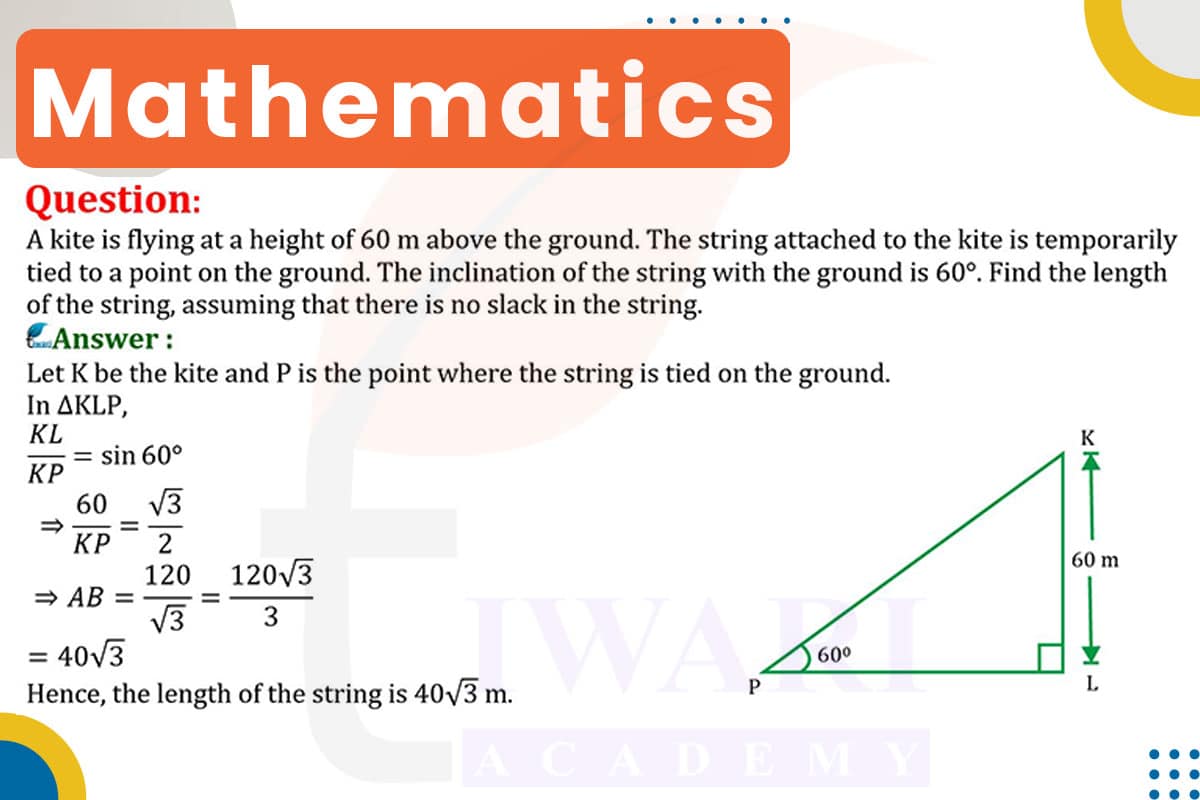To find the length of the kite string, we use trigonometry, specifically the cosine function. The cosine of an angle in a right-angled triangle is the ratio of the adjacent side (height of the kite above the ground) to the hypotenuse (length of the string).
Given: Height of the kite = 60 m, Angle of inclination = 60°. The cosine of 60° is 1/2.
Using the formula cos(60°) = (60 m)/(length of the string), we have 1/2 = 60/length.
Solving for the length of the string, we get length of the string = 60 × 2, which is 120 meters. Therefore, the length of the string is 120 meters.

Let’s discuss in detail
Trigonometric Applications in Kite Flying
Trigonometry, a branch of mathematics, finds its application in various real-life scenarios, including the simple joy of kite flying. The problem at hand involves determining the length of a kite string when the kite is flying at a certain height and the string makes a specific angle with the ground. This scenario is a perfect example of how trigonometry can be used to solve practical problems. By applying trigonometric functions, one can calculate distances and lengths that are not directly measurable, such as the length of a kite string in flight.
Understanding the Kite Flying Scenario
In this scenario, a kite is flying at a height of 60 meters above the ground. The string of the kite is tied to a point on the ground, forming an angle of 60° with it. This setup creates a right-angled triangle with the ground, the kite string, and the height of the kite. The challenge is to determine the length of the kite string, assuming it is taut and forms a straight line from the point where it’s tied to the kite itself.
The Role of Cosine in Trigonometry
To solve this problem, we use the cosine function from trigonometry. The cosine of an angle in a right-angled triangle is the ratio of the length of the adjacent side (in this case, the height of the kite) to the length of the hypotenuse (the kite string). The cosine function is particularly useful in scenarios where the length of one side of a triangle is known, and the length of the hypotenuse is to be determined.
Applying the Cosine Function
Applying the cosine function to the 60° angle, we use the formula cos(60°) = (height of the kite)/(length of the string). The cosine of 60° is known to be 1/2. Substituting the known values into the formula, we get 1/2 = (60 m)/(length of the string).
Calculating the Length of the Kite String
Solving the equation for the length of the kite string, we multiply both sides by the length of the string and then divide by 1/2. This gives us length of the string = 60 m × 2, which simplifies to 120 meters. This calculation shows that the kite string is 120 meters long, allowing the kite to reach the height of 60 meters at the given angle.
Trigonometry in Everyday Life
This example illustrates the practical application of trigonometry in everyday activities like kite flying. The ability to calculate lengths and distances using angles is a powerful tool, not just in theoretical mathematics but also in real-life situations. Trigonometry helps bridge the gap between abstract concepts and their practical uses, demonstrating the importance of mathematical principles in understanding and interacting with the world around us. This scenario, in particular, shows how trigonometry can provide solutions to problems that involve indirect measurement, making it an invaluable tool in various fields and hobbies.
Discuss this question in detail or visit to Class 10 Maths Chapter 9 for all questions.
Questions of 10th Maths Exercise 9.1 in Detail

